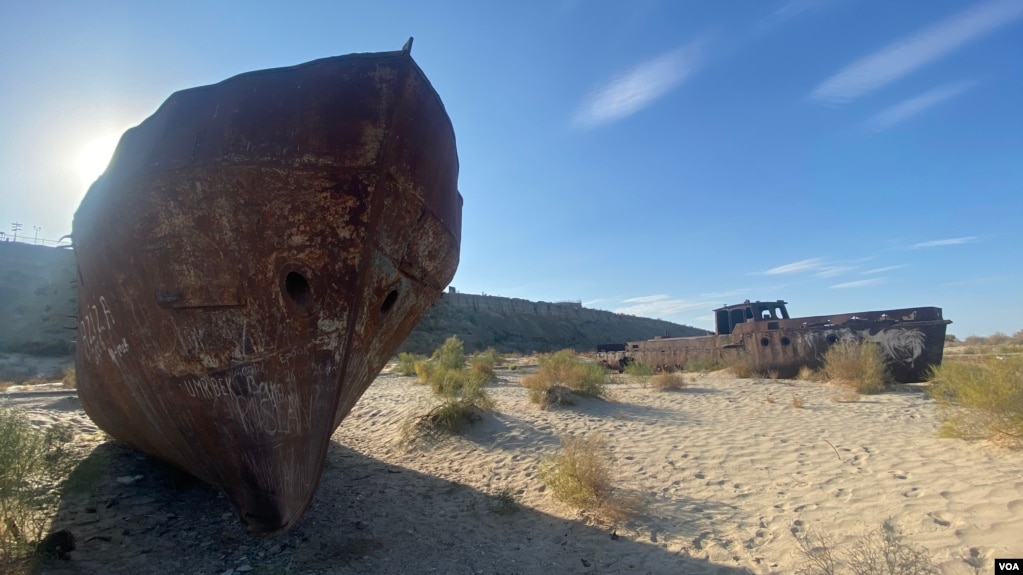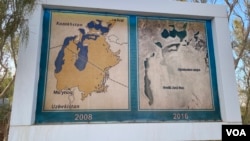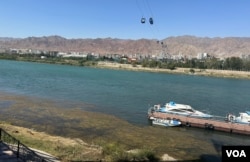VOA News
April 07, 2024

Climate change and water scarcity are harsh realities facing Central Asia. Glaciers in the east, in the mountains of Kyrgyzstan and Tajikistan, are rapidly melting, while in the west, Uzbekistan and Kazakhstan, the Aral Sea has turned into a desert.
According to the World Bank, almost a third of the region’s 80 million people lack access to safe water, highlighting the urgent need to modernize outdated infrastructure. Afghanistan is building a canal that could exacerbate the crisis.
Shrinking rivers, drying sea
Last summer and fall in Uzbekistan and Tajikistan, people living along the Syr Darya and Amu Darya rivers described to VOA extreme weather conditions — droughts and floods posing existential dangers.
“It’s all about water, our constant worry,” said Ganikhan Salimov, a cotton farmer in Uzbekistan’s Ferghana region, bordering Kyrgyzstan and Tajikistan.
“This water is not just for us, but a source of life for the entire region,” he said, pointing to a muddy canal near his crops.
The Syr Darya River originates in the Tian Shan Mountains in Kyrgyzstan and Uzbekistan, flowing more than 2,250 kilometers (1,400 miles) west through Tajikistan and Kazakhstan to the northern remnants of the Aral Sea, which has been gradually disappearing for five decades.
The Amu Darya stems from the confluence of the Vakhsh and Panj rivers. Separating Tajikistan and Afghanistan, it runs for 2,400 kilometers (almost 1,500 miles) northwest through Uzbekistan and Turkmenistan into the southern remnants of the Aral.
“We don’t fool ourselves with this magnificent view,” said a local resident who introduced himself only as Bayram, enjoying a hot day with his family on a bank of the Amu Darya in Uzbekistan’s Karakalpakstan Republic, adjacent to Turkmenistan.
“It continuously shrinks and becomes nothing by the time it winds its way to the Aral Sea, which is nowhere to be found,” he said.
A new water deal?
Aggravating the situation, Taliban-run Afghanistan is building a 285-kilometer (177-mile) canal off the Amu Darya, which could draw off 20% to 30% of the water that now goes to Uzbekistan and Turkmenistan.
Tashkent and Ashgabat have been in separate talks with the Taliban, who have argued that the purpose of the canal, called Qosh Tepa, is not to deprive their neighbors of a strategic resource but to provide more water for Afghans.
Central Asian experts express concern over the quality of the Qosh Tepa construction, which started in 2022. Officials in Tashkent say they have offered Kabul technical assistance.
Uzbek President Shavkat Mirziyoyev calls the Taliban “a new stakeholder” not bound by any prior obligations to their northern neighbors. Last September in Tajikistan, at a meeting on the Aral Sea, he proposed a dialogue of riparian countries.
“We believe it is necessary to set up a joint working group to study all aspects of the construction of the Qosh Tepa canal and its impact on the water regime of the Amu Darya involving our research institutes,” Mirziyoyev said.
No progress has been made since then, but Eric Rudenshiold, a former U.S. official with decades of experience working with Central Asian governments, believes the best outcome would be a new water-sharing agreement.
“Afghanistan, Uzbekistan, Tajikistan, Turkmenistan, all are facing water shortage issues, and so cooperation is really the only answer. And the question is, at what point these countries do that. Cooperation is much better than conflict,” he told VOA.
They would not even talk to each other on these issues until recently, Rudenshiold said.
“We’ve seen Central Asian states lean forward to engage with the Taliban, and I think that’s a big step,” he said.
While optimistic about the prospects for regional dialogue, Rudenshiold said he doubts Western governments will participate, given their strong opposition to the Taliban and its repressive policies.
“I think the region is going to have to resolve this issue itself, not relying on international organizations or other powers, but actually having the countries come together,” Rudenshiold said.
He sees enough leverage to negotiate: Uzbekistan, Tajikistan and Turkmenistan provide power to Afghanistan. “The question is, how do you add water into that equation?”
“Yes, Afghanistan can take water for agriculture and drinking water. The problem is it’s still depleting, and Afghanistan needs to be part of the solution,” Rudenshiold said.
America’s offering
At a recent forum at the Wilson Center in Washington, U.S. officials and Central Asian diplomats highlighted growing water demand and worsening environmental conditions.
Tajikistan’s ambassador, Farrukh Hamralizoda, said that “more than 1,000 of the 30,000 glaciers” in his country have already melted.
“Every year, we suffer from floods, landslides, avalanches and other water-related natural disasters,” Hamralizoda said, adding that his mountainous country generates 98% of its electricity from hydropower.
Kyrgyzstan’s ambassador, Baktybek Amanbaev, said glaciers have also been vanishing in his similarly mountainous country, which he said hosts 30% of the clean water in the five former Soviet republics that make up Central Asia.
“We need effective water management to be able to estimate water reserves and flows,” Amanbaev said.
To that end, the U.S. Agency for International Development is funding MODSNOW, a digital program for hydrological forecasting that uses satellite imaging to monitor snow depth and melt and water flows from the mountains.
By providing governments and local stakeholders with accurate and timely data, the U.S. hopes to enable informed decision-making and sustainable management of resources.
“With accelerated snowmelt and heavy rainfall events also comes the greater risk of landslides and other severe natural disasters,” said Anjali Kaur, the agency’s deputy administrator, also speaking at the Wilson Center.
 Afghanistan Peace Campaign
Afghanistan Peace Campaign


